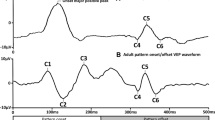Abstract
Thirty patients were referred to our visual evoked potential laboratory with complaints of profound acuity loss in one or both eyes. However, the objective ophthalmologic findings were normal, including pupillary reaction, and anterior segment and fundus examinations. Transient visual evoked potentials to a 2.3-c/deg sinusoidal grating pattern were found to be present in 26 of these 30 patients. Visual evoked potentials may be used as a measure of afferent pathway integrity.
Similar content being viewed by others
References
Odom J, Green M. Visually evoked potential (VEP) acuity: Test ability in a clinical pediatric population. Acta Ophthalmol 1984; 62: 993–8.
Celesia G, Bushnell D, Cone Toleikis S, Brigell M. Cortical blindness and residual vision: Is the ‘second’ visual system in humans capable of more than rudimentary visual perception? Neurology 1991; 41: 862–9.
Hess C, Meienberg O, Ludin H. Visual evoked potentials in acute occipital blindness: Diagnostic and prognostic value. Neurol 1982; 227: 193–200.
Miyata Y, Motomura S, Tsuji Y, Koga S. Hepatic encephalopathy and reversible cortical blindness. Am J Gastroenterol 1988; 83: 780–2.
Regan D, Regan DM, Tibbles J. Evoked potentials during recovery from blindness recorded serially from an infant and his normally sighted twin. Electroencephalogr Clin Neurophysiol 1982; 54: 465–8.
Aldrich M, Alessi A, Beck R, Gilman S. Cortical blindness: Etiology, diagnosis, and prognosis. Ann Neurol 1987; 21: 149–58.
Bodis-Wollner I, Mylin L. Plasticity of monocular and binocular vision following cerebral blindness: Evoked potential evidence. Electroencephalogr Clin Neurophysiol 1987; 68: 70–74.
Adachi-Usami E. Visually evoked cortical potentials in cortical blindness. In: Heckenlively JR, Arden GB, eds. Principles and practice of clinical electrophysiology of vision. St Louis, Mosby Year Book, 1991: 578–80.
Kramer K, La Piana F, Appleton B. Ocular malingering and hysteria: Diagnosis and management. Surv Ophthalmol 1979; 24: 89–96.
Howard J, Dorfman L. Evoked potentials in hysteria and malingering. J Clin Neurophysiol 1986; 3: 39–49.
MacCana F, Bhargava S, Kulikowski J. Flash and pattern VEPs: Examples of cases of hysterical amblyopia and provoked visual impairment (Uhthoff's sign). Ophthalmol Physiol Opt 1983; 3: 55–60.
Smith C, Beck R, Mills R. Functional disease in neuro-ophthalmology. Neurol Clin 1983; 1: 955–71.
Holder G. Electrodiagnostic testing in malingering and hysteria. In: Heckenlively JR, Arden GB, eds. Principles and practice of clinical electrophysiology of vision. St Louis, Mosby Year Book, 1991: 573–6.
Sedwick L. The perils of Pauline: Visual loss in a tippler. Surv Ophthalmol 1991; 35: 454–62.
Matsui Y, Mehta M, Katsumi O, Brodie S, Hirose T. Electrophysiological findings in paraneoplastic retinopathy. Graefes Arch Clin Exp Ophthalmol 1992; 230: 324–8.
Bobak P, Friedman R, Brigell M, Goodwin J, Anderson R. Visual evoked potentials to multiple temporal frequencies. Arch Ophthalmol 1988; 106: 936–40.
Bodis-Wollner I, Harnois C, Bobak P, Mylin L. On the possible role of temporal delays of afferent processing in Parkinson's disease. J. Neural Transm Suppl 1983; 19: 243–52.
Bobak P, Bodis-Wollner I, Guillory S, Anderson R. Aging differentially delays visual evoked potentials to checks and gratings. Clin Vision Sci 1989; 4: 269–74.
Bobak P, Bodis-Wollner I, Guillory S. The effect of blur and contrast on VEP latency: Comparison between checks and sinusoidal grating patterns. Electroencephalogr Clin Neurophysiol 1987; 68: 247–55.
Douthwaite W, Connor H. Mental concentration and the pattern reversal visual evoked response. Opt Vis Sci 1989; 66: 61–5.
Bumgartner J, Epstein C. Voluntary alteration of visual evoked potentials. Ann Neurol 1982; 12: 475–8.
Sokol S, Moskowitz A. The effect of retinal blur on the peak latency of the pattern evoked potential. Vision Res 1981; 21: 1279–86.
Lovasik J, Spafford M, Szymkiw M. Modification of pattern reversal VERs by ocular accommodation. Vision Res 1985; 25: 599–608.
Uren S, Stewart P, Crosby P. Subject cooperation and the visual evoked response. Invest Ophthalmol Vis Sci 1979; 18: 648–52.
Rover J, Bach M. Pattern electroretinogram plus visual evoked potential: A decisive test in patients suspected of malingering. Doc Ophthalmol 1987; 66: 245–51.
Towle V, Sutcliffe E, Sokol S. Diagnosing functional visual deficits with the P300 component of the visual evoked potential. Arch Ophthalmol 1985; 103: 47–50.
Bodis-Wollner I, Atkin A, Raab E, Wolkstein M. Visual association cortex and vision in man: Pattern-evoked occipital potentials in a blind boy. Science 1977; 198: 629–31.
Celesia G, Archer C, Kuroiwa Y, Goldfader P. Visual function of the extrageniculocalcarine system in man: Relationship to cortical blindness. Arch Neurol 1980; 37: 704–6.
Sokol S, Hedges T III, Moskowitz A. Pattern VEPs and preferential looking acuity in infantile traumatic blindness. Clin Vision Sci 1987; 2: 59–61.
Author information
Authors and Affiliations
Rights and permissions
About this article
Cite this article
Bobak, P., Khanna, P., Goodwin, J. et al. Pattern visual evoked potentials in cases of ambiguous acuity loss. Doc Ophthalmol 85, 185–192 (1993). https://doi.org/10.1007/BF01371133
Accepted:
Issue Date:
DOI: https://doi.org/10.1007/BF01371133




